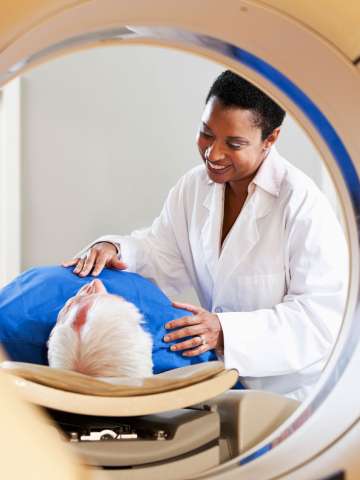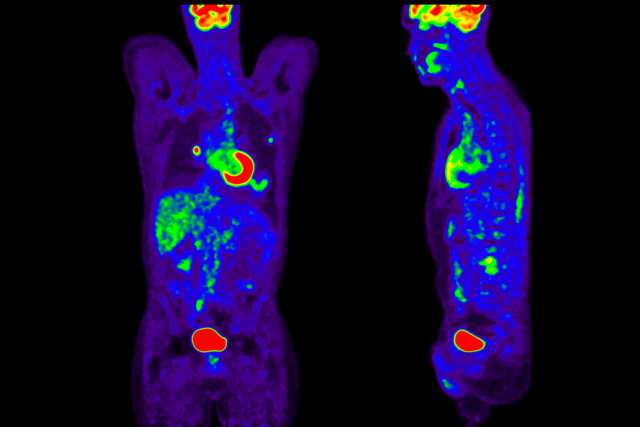Nuclear Medicine
UCLA Health nuclear medicine specialists have extensive experience using sophisticated imaging techniques to diagnose and manage diseases. Our knowledgeable, highly skilled team helps children and adults.

UCLA Health excellence in Nuclear Medicine
At the UCLA Health Ahmanson Translational Imaging Division, our experts use nuclear medicine procedures to diagnose, manage and treat a range of conditions. We’re skilled at using groundbreaking imaging technology to deliver the highest level of care to people of all ages. Highlights of our program include:
Expertise in diagnosis and treatment: We lead the nation in state-of-the-art imaging and therapy using nuclear medicine technology. Our highly skilled specialists work as a team to evaluate and stage disease, provide a precise diagnosis and offer potential treatments.
Convenient care: We perform nuclear medicine procedures at several locations, including inpatient and outpatient clinics in Westwood, Santa Monica, Thousand Oaks and Santa Clarita. Our compassionate team makes it as easy as possible for you to get the care you need.
Groundbreaking therapies: Nuclear medicine experts work with a coordinated team of specialists to treat neuroendocrine tumors (NETs) and prostate cancer. The Nuclear Medicine Clinic at UCLA was one of the first medical centers in the US to treat NET patients with Lutathera®, and prostate cancer patients with Pluvicto®.
Precise prostate cancer staging: UCLA Health nuclear medicine experts use PET/CT with an imaging probe that targets the prostate-specific membrane antigen (PSMA). PSMA PET/CT scans help diagnose and stage prostate cancer with unparalleled accuracy. The results of these scans enable the patient’s care team to plan more effective treatments.
Commitment to research: Our specialists are at the forefront of the latest advances in nuclear medicine technology. We are actively involved with research to develop new nuclear medicine techniques that can help doctors diagnose, manage and treat cardiovascular disease, cancer and neurological disease.
What is Nuclear Medicine?
Nuclear medicine uses small amounts of radioactive tracers or drugs to help doctors diagnose and treat a variety of diseases. During a nuclear medicine procedure, your doctor uses a large scanner to take detailed pictures of your body. Nuclear Medicine therapies are performed by injecting or swallowing the radioactive drug.
The radioactive tracer or drug is attracted to specific organs, bones, tissues or cells. Your doctor uses special cameras that can image where the tracers accumulate and "light up" in your body. This information helps your doctor diagnose and evaluate many conditions.
What can I expect during my nuclear medicine procedure?
Before your procedure, your doctor or a nuclear medicine technologist will give you a small amount of radioactive tracer. Most tracers are injected into a vein, some are swallowed or inhaled. This is followed by a scan. Depending on the type of procedure, you may need to wait a few hours or a few days between getting the tracer and having the scan.
After your scan, it is safe for you to go home and resume your usual activities. The radioactive material usually loses its radioactivity within a few hours and also leaves your body naturally when you go to the bathroom.
Reactions to nuclear medicine tracers and drugs are extremely rare.If you have concerns or any allergies, talk to your doctor. Nuclear medicine procedures are safe. The total amount of radiation you receive from a nuclear medicine exam is comparable to the amount you receive during an X-ray or a CT scan.
When the images from your scan are ready, your doctor reviews them and creates a report for your care team. Your care team will contact you to review the results, answer questions and discuss next steps.
Our areas of care
At UCLA Health, we use nuclear medicine procedures to diagnose disease, manage conditions, plan treatment and deliver targeted therapies. Nuclear medicine technology enables us to:
Diagnose conditions: Our experts perform scans of the heart, thyroid, liver, kidneys, gallbladder, lungs and other organs to see how the organs are working and to diagnose a range of conditions. Examples of these conditions include cardiovascular disease, Alzheimer’s disease, epilepsy and cancers.
Manage disease and plan treatments: We use the results of nuclear medicine scans to gather information about the character, and stage of the disease as well as how it is responding to therapy. Using this information, your care team can develop the most appropriate treatment plan while lowering the risk of future disease.
Provide effective therapies: Nuclear medicine allows us to deliver therapy directly to certain cancers. Examples include neuroendocrine tumors, prostate cancer and thyroid cancer.
Nuclear medicine scans and procedures we offer
Our team uses sophisticated imaging technology to deliver the latest advances in care. We specialize in all nuclear medicine procedures, including:
Positron emission tomography and computerized tomography (PET/CT) scans
These imaging tests create detailed pictures of the body using safe amounts of a radioactive tracer. The images allow us to see how organs are working and evaluate abnormal, damaged or cancerous tissues.
After giving you the tracer, your doctor performs the PET/CT scan. The tracer collects in certain areas of the body and shows up on the images. Depending on the procedure, these highlighted areas may indicate tumors, evidence of Alzheimer’s disease or problems with the heart or blood vessels.
Cardiac perfusion scan (nuclear stress test)
This imaging study evaluates blood flow through the arteries of your heart. We inject a small amount of safe, radioactive tracer into a vein. As the tracer moves through your heart muscle, we take images with a scanner that allows us to check the blood vessels in your heart. We can identify any damaged areas or blood flow problems based on how the tracer looks on the scan.
We perform this test while you are resting and after you have exercised (nuclear stress test). Your doctor may ask you to walk on a treadmill or do another activity that increases your heart rate before doing the second scan. We then compare the resting images to the post-exercise images.
A cardiac perfusion scan helps us see how much blood is reaching the heart. It allows us to determine the cause of chest pain or to assess damage after a heart attack.
Prostate-specific membrane antigens (PSMA) PET/CT imaging
This advanced imaging study allows us to locate prostate tumors so we can develop more effective treatments. The test uses a safe, radioactive tracer. Your doctor injects the tracer into a vein in your arm. As the tracer flows through your bloodstream, it attaches to specific proteins (called PSMA) that develop on the surface of prostate cancer tumors.
Using a sophisticated scanner, your doctor looks at images of your prostate and surrounding organs. They can pinpoint the location of any tumors once the tracer highlights them on the scan. This advanced technology leads to more precise diagnoses and therapies. Learn more about the PSMA PET/CT scan.
Targeted treatment for neuroendocrine tumors (NET)
At UCLA Health, we offer Lutathera®, a modern treatment for advanced (metastatic) neuroendocrine tumors of the stomach, gut or pancreas. These tumors are sometimes called carcinoid tumors. As part of a clinical trial prior to FDA approval, UCLA Health experts treated more patients with Lutathera® than any other medical center in the nation. This means we have significant experience using this therapy.
Lutathera® is a type of peptide receptor radionuclide therapy (PRRT), a treatment that targets tumors and delivers a high dose of radiation to destroy them. When your doctor injects Lutathera® through a vein, it travels through your bloodstream and attaches to the cells of the neuroendocrine tumor. Once it’s attached to these cells, Lutathera® delivers a targeted dose of radiation to destroy the cancer cells.
Lutathera® (Lutetium 177-DOTATATE) has been shown to reduce disease progression in people with these tumors. To deliver treatments for NETs, we work closely with a multispecialty team that includes oncologists, endocrinologists, surgeons and interventional radiologists. Learn more about the UCLA Health neuroendocrine tumor program (NET).
Meet our team
Our team includes recognized leaders in the field of nuclear medicine that diagnose, manage and treat disease. We work with specialists in other departments to ensure coordinated care for children and adults. Team Directory >
Contact us
Call 310-794-1005 to connect with a UCLA Health nuclear medicine expert.
Find your care
You can trust UCLA Health to deliver an accurate diagnosis and outstanding care using the latest advances in nuclear medicine. Call 310-794-1005 to connect with an expert.
